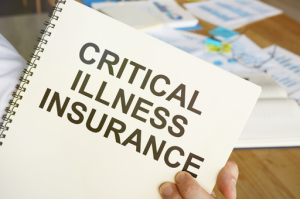
Critical Illness Insurance
 While standard health insurance will usually pay for hospital care, hospital stays continue to get shorter and outpatient care increases even for those with critical illness. There are deductibles and copays associated with outpatient care as well as hidden non-medical financial burdens associated with serious illness such as lost wages and benefits, increased transportation costs, child care, lodging near treatment facilities, and meals away from home.
While standard health insurance will usually pay for hospital care, hospital stays continue to get shorter and outpatient care increases even for those with critical illness. There are deductibles and copays associated with outpatient care as well as hidden non-medical financial burdens associated with serious illness such as lost wages and benefits, increased transportation costs, child care, lodging near treatment facilities, and meals away from home.
Critical illness insurance covers the medical cost of treating life-threatening illnesses that standard health insurance doesn’t pay, which may include out-of-network referrals or treatments not covered by a traditional policy and many non-medical costs. Although your policy will have a benefit amount, some policies do not guarantee payment of the full amount.
Conditions that are considered a critical illness may vary.
- They usually include heart attack, stroke, organ transplant, coronary bypass, angioplasty, and most types of cancer.
- Other conditions that may be included are organ damage, blindness, deafness, paralysis, ALS (Lou Gehrig’s disease), lupus, tetanus, malaria, sickle-cell anemia, cystic fibrosis, severe burns, or coma.
- You may be able to choose what conditions are covered in your plan and whether or not the settlement applies to each condition or all conditions in total.
- Chronic illnesses such as diabetes and asthma are usually exempt from coverage, even if they are the cause of your critical condition.
The more your health insurance covers, the less the need for critical illness insurance. For example, if you are having an angioplasty or coronary artery bypass, you will only get a small portion of the benefit, since they are in-hospital procedures that most health insurance pays for completely and outpatient care and recovery time afterwards is limited.
 Before getting critical illness insurance it may be worth comparing the cost of increasing your health insurance coverage to the cost of purchasing critical illness insurance. If you have Medicare, you may be more able to afford a Medicare supplement policy than critical illness insurance. If you have Medicaid which covers most healthcare costs, you may not need to consider this insurance at all.
Before getting critical illness insurance it may be worth comparing the cost of increasing your health insurance coverage to the cost of purchasing critical illness insurance. If you have Medicare, you may be more able to afford a Medicare supplement policy than critical illness insurance. If you have Medicaid which covers most healthcare costs, you may not need to consider this insurance at all.
Critical illness insurance is fairly inexpensive, even more so if purchased as a rider on your current life insurance.
Additional Details About Critical Illness Insurance
Even if identified as a critical illness by your policy, you may not get all or any of your benefit if your illness is not serious or life-threatening. You may not receive any benefit at all if you have a non-life-threatening/good prognosis cancer or if a potentially life-threatening cancer is diagnosed and treated in the early stages.
The amount of coverage is fairly limited, typically $10,000-$50,000, although it is tax-free. While helpful, this amount may only make a small dent in the cost associated with many critical illnesses. You may be able to increase your coverage if you have a physical examination and are healthy.
The benefits can be paid out in different ways.
- The most common is a lump sum based on terms of the policy for a particular illness.
- You could choose indemnity benefits, which are paid out in amounts to offset medical costs for hospital and ICU stays, chemotherapy, radiation, and corrective or preventive surgery.
- You could earmark some of the benefits to pay for specific costs such as transportation, lodging near treatment facilities, or preventive tests such as mammograms, Pap smears, and colon screenings.
- Some policies offer a premium-return feature, which returns your premiums if coverage is maintained without being used for a certain period of time.
The total amount could be received for each of a limited number of covered illnesses. For example, if you have a benefit amount of $30,000 and develop cancer, have a stroke, and get an organ transplant, your total benefit could be $90,000. Benefits for a single category cannot be carried over to another. With the same example, if you only use $20,000 of your stroke benefit, you can’t use the remaining $10,000 for your cancer.
 This amount could be the total paid for the entire group of illnesses collectively, meaning you would only receive $30,000 no matter how many of the illnesses you develop.
This amount could be the total paid for the entire group of illnesses collectively, meaning you would only receive $30,000 no matter how many of the illnesses you develop.
The more illnesses that are covered, the higher the premiums. Covering multiple illnesses increases the risk of needing benefits. Applying the maximum benefit to more than one illness increases the amount the company is at risk for.
Non-medical expenses that can be paid for include mortgage payments, daily living expenses, transportation expenses including costs of travel to and from treatment centers and retrofitting vehicles to carry scooters or wheelchairs, and/or home modifications such as installing ramps or lifts. You may even use the funds to take a vacation as respite when you are able to.
Critical illness insurance can have significant shortcomings.
- The benefit for any covered illness or category is usually a single lump sum payment. In this case, your benefit is gone and you are not covered if your disease comes back or if you suffer a second stroke or heart attack. Some companies allow you to get a partial benefit, leaving the remainder in case of a recurring diagnosis.
- An illness will only be covered under the specific circumstances outlined in the policy. For example, to get the benefit you may need to:
- Be ill for a specific number of days;
- Survive for a specific amount of time after your diagnosis;
- Have your cancer spread beyond the initial point of discovery or be life-threatening; and/or
- Have neurological damage persist for more than 30 days after having a stroke.
- There may be age limits for payout on your policy.
- You may become ineligible for benefits after a certain age, usually 70-75 years old.
- If your policy has age reduction schedules, your potential benefit or percent of benefit paid decreases as you get older.
Like life insurance, benefits will not be paid if the illness was caused by invalidating criteria such as a criminal act, self-inflicted condition, suicide attempt, or substance abuse.
Alternatives include a health savings account, a flexible spending account, disability insurance, or more comprehensive health insurance, such as adding Medigap insurance if you are on Medicare.
